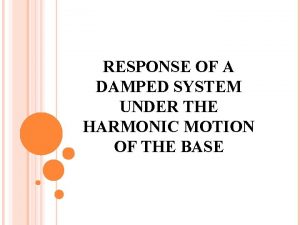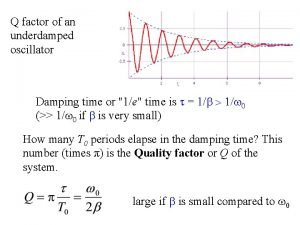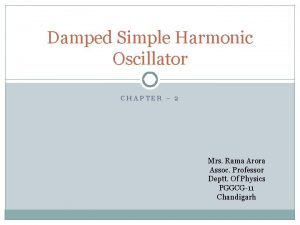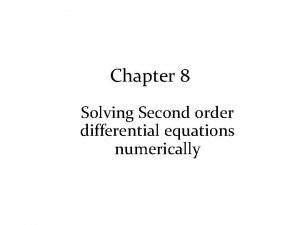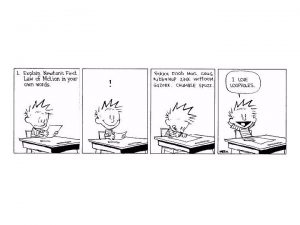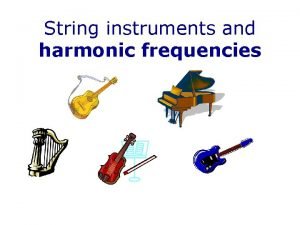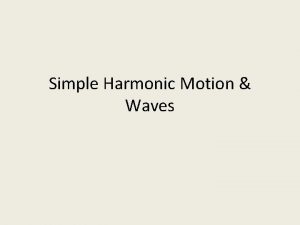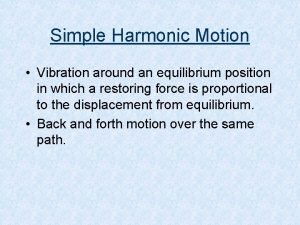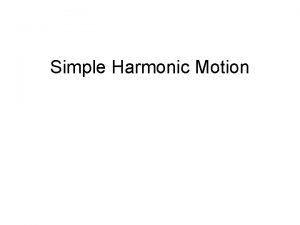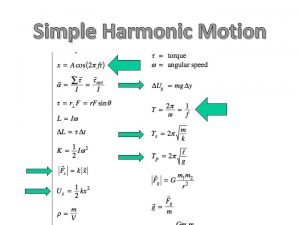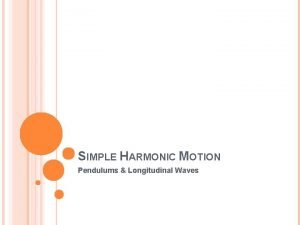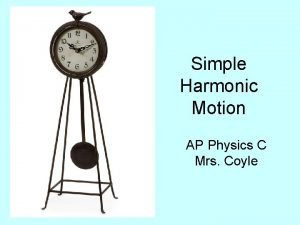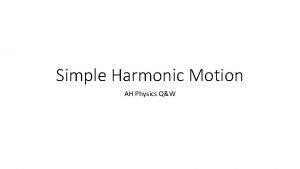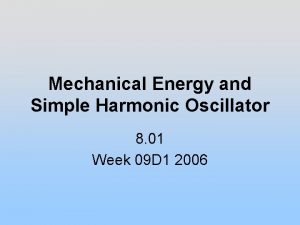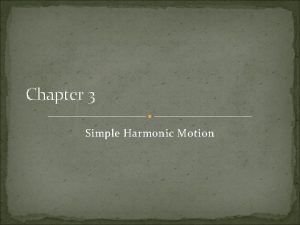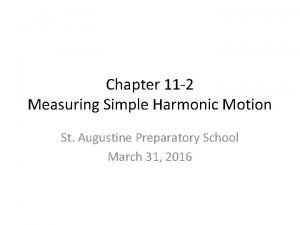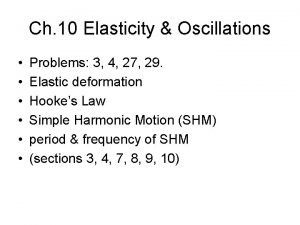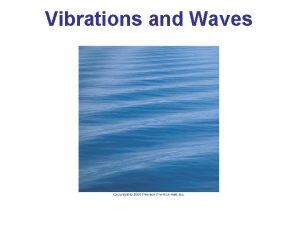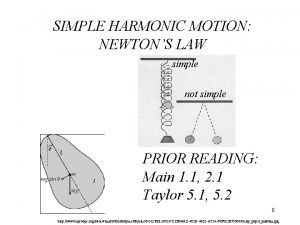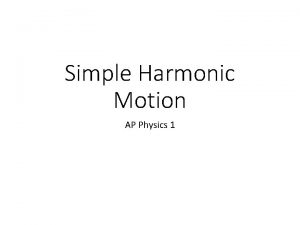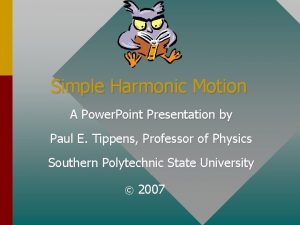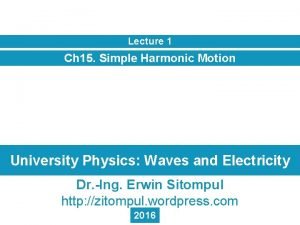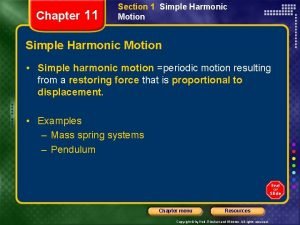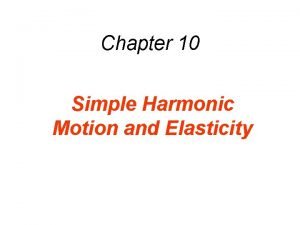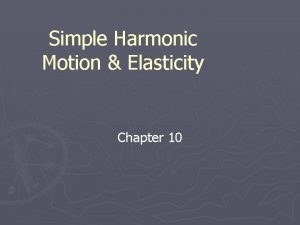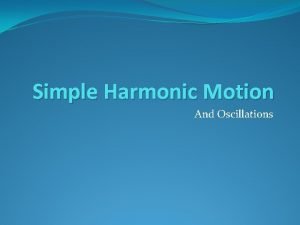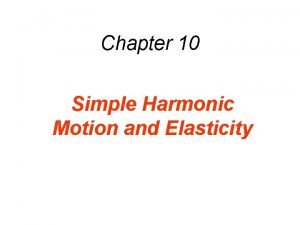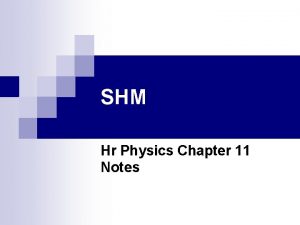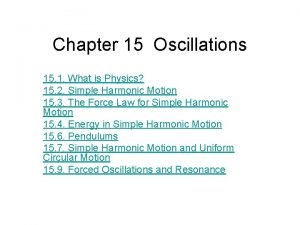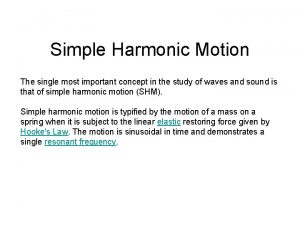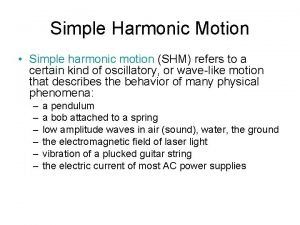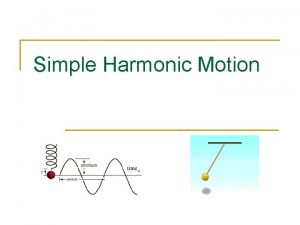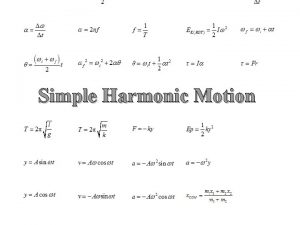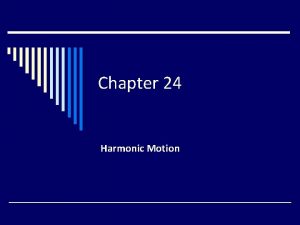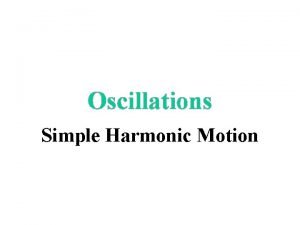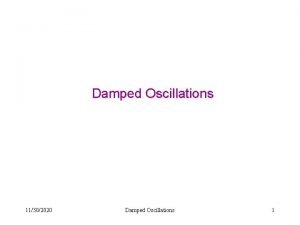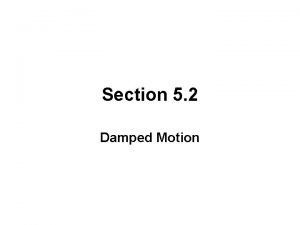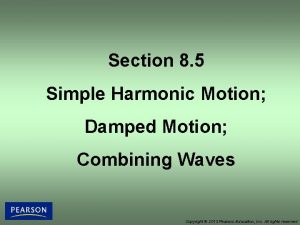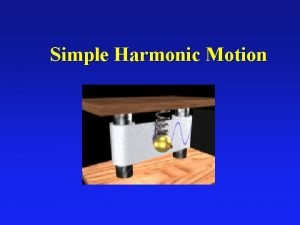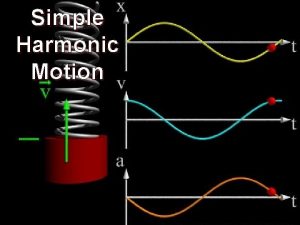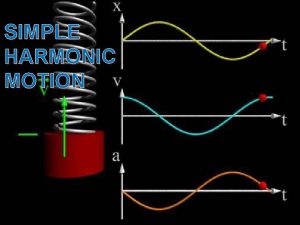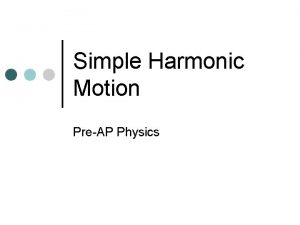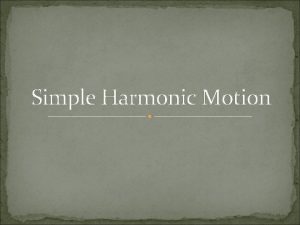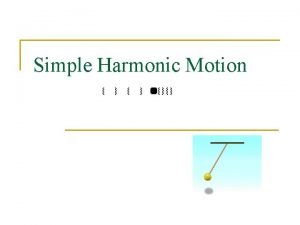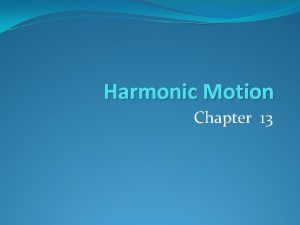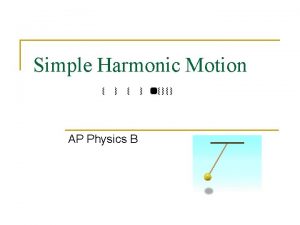Damped simple harmonic motion 27 T H AUGUST


































- Slides: 34

Damped simple harmonic motion 27 T H AUGUST 2019 1

Phase space • In classical mechanics, the phase space is the space of all possible states of a system; the state of a mechanical system is defined by the constituent positions and velocities or momenta. • The horizontal coordinate represents the position x while the vertical coordinate represents the velocity v. • The future state of motion of such a particle is completely specified if its positon and velocity are know simultaneously. • The trajectory of these points in phase space represents the complete time history of the particle. 2

Simple harmonic oscillator : no damping force • A general solution for simple harmonic motion may be written as • The corresponding velocity is found to be • The trajectory of the oscillator in the phase space becomes • The motion repeats itself, a consequence of the conservation of the total energy of the harmonic oscillator. 3

Phase space diagram for undamped oscillator • An object undamped oscillating back and forth along x axis • Position x(t) (leads/lags) velocity v(t) by …. . rad • The phase diagram plot (phase space) is a combined plot of x(t) and v(t) giving a clockwise ellipse. • What happens when the amplitude of the motion is differed. ? http: //www. acs. psu. edu/drussell/Demos/phase-diagram. html http: //teacher. pas. rochester. edu/PHY 235/Lecture. Notes/Chapter 03. htm 4

Phase space diagram for (lightly) damped oscillator • The oscillator loses energy during each cycle. • x(t) and v(t) exponentially decrease in amplitude as time proceeds. • In classical mechanics, this phase space described as an "attractor". http: //www. acs. psu. edu/drussell/Demos/phase-diagram. html 5

Damped simple harmonic motion • Equation of motion • General solution for the differential equation • Where t = time and C 1, C 2 are arbitrary constants. 6

Three possible conditions (1) Heavy damping : (2) Critically damping: (3) Lightly damping: Displacement as function of time for a one-dimensional damped oscillator https: //www. quora. com/What-is-damping-ratio 7

Heavy damping • To illustrate the behavior of the heavy damping (over damping), the displacement x(t) can be rewritten as • Where • This represents non-oscillating behavior. http: //calculus. seas. upenn. edu/? n=Main. Computing. Taylor. Series 8

Derivation of the heavy damping displacement x 9

Heavy damping graph • Given an initial condition x(t=0) = 0. • The displacement x(t) is written as x(t) = …………………. • The graph returns to zero displacement quite slowly without oscillating about its equilibrium position. 10

Critically damping • Under the critically damping, the displacement becomes • Where A is a constant length and B is a given velocity which depends on the boundary conditions. • Suppose a critical damping system has zero displacement at t = 0 and receives an impulse which gives it an initial velocity V. Determine the maximum displacement. • Also the motion is non-oscillatory. 11

Comparison between heavy damping and critical damping • Heavy damping of a damped oscillator will cause it to approach zero amplitude more slowly than for the case of critical damping. • Critical damping is of practical importance in mechanical oscillators which experience sudden impulses and required to return to displacement in minimum time. 12

Lightly damping • The behavior of the lightly damping oscillating system is described by • The amplitude of the oscillator decays exponentially with time according to • The damping coefficient r controls how fast the oscillating system comes to rest. 13

Analysis of the lightly damping displacement • Referring to • The bracket has the dimensions of frequency and can be written as • • Therefore, and = frequency of ideal simple harmonic frequency (no damping!) ; provided that • A and are constants which depend on the motion at t = 0. • This lightly damping oscillation can then be compared to the simple harmonic oscillation. 14

Derivation of lightly damping displacement x TRY PROBLEM 2. 3 15

Differences between the undamped oscillation and underdamped oscillation • Recall, the undamped oscillatory displacement : • The underdamped oscillatory displacement : • There are two difference : (1) the presence of the real exponential factor leading to a gradual death of oscillations and (2) the underdamped oscillator’s angular frequency. • The underdamped oscillator vibrates a little more slowly than does the undamped oscillator. • The period of underdamped oscillator is given by 16

Plasma oscillations-what is plasma? Plasma is simply an ionized or electrically charged gas, and is often described as the fourth state of matter, i. e. when energy is added to a solid (first state) it becomes a liquid (second state); with more added energy it becomes a gas (third state) and when further energy is added it eventually disassociates to become a plasma. https: //tetronics. com/our-technology/what-is-plasma/ 17

Plasma oscillation : the ionosphere • The ionosphere is defined as the layer of the Earth's atmosphere ionized by solar and cosmic radiation. It lies 75 -1000 km above the Earth. • Because of the high energy from the Sun and from cosmic rays, the atoms in this area have been stripped of one or more of their electrons, or “ionized, ” and are therefore positively charged. The ionized electrons behave as free particles. The particles are in the plasma state. • The ionosphere influences radio propagation to distant places on the Earth, and between satellites and Earth. http: //solar-center. stanford. edu/SID/activities/ionosphere. html 18

Plasma oscillations : Plasma characteristics • The plasma is overall neutral, i. e. , the number density of the electrons and ions are the same. http: //homepage. physics. uiowa. edu/~rmerlino/129 Fall 12/29_129_Plasma_oscillations. pdf 19

Plasma oscillation : the analysis • The positive region on the left side and the negative region on the right side can be considered as two parallel charged planes, each having a cross sectional area and width x. TRY PROBLEM 2. 8 20

Energy Consideration • The total energy of the damped harmonic oscillator is given by • Differentiate the total energy with respect to t : • From the equation of motion of the damped oscillation : • The time rate of change of total energy is found to be the product of the damping force and the velocity • Because this always either zero (undamped) or negative (underdamped), the total energy continually decreases. 21

Damping ratio • Damping Ratio ( = zeta) is dimensionless parameter which describes how an oscillating or vibrating body comes to rest. https: //www. quora. com/What-is-damping-ratio 22

What is the damping ratio ? • The damping ratio gives the level of damping in a system relative to critical damping. • The damping ratio can be defined as the ratio of the damping coefficient in the system's differential equation to the critical damping coefficient. • Example 1 : A spring-mass damper system has mass of 100 kg, stiffness of 3000 N/m and damping coefficient of 300 kg/s. Calculate the undamped natural frequency, the damping ratio and the damped natural frequency. Does the system oscillate? 23

solution 24

Values for describing the damping of an oscillator • Three different values are used to describe the behavior of a damped oscillator. • They are composed of (1) Logarithmic decrement, (2) Relaxation time and (3) Quality Factor or Q-Value. • The exponential decay factor exp(-rt/2 m) expresses the rates at which the amplitude and energy is reduced. 25

Logarithmic decrement (1) • This value represents the rate at which the amplitude decreases with time. • Suppose the expression of the lightly damped oscillation, • Given = /2 and at t = 0, x = A 0. • The lightly damped can be described by • The behavior is shown as -------> 26

Logarithmic decrement (2) • From the graph in the previous slide, the amplitude at nth period can be written as • For example • Notice that • The logarithmic decrement 27

Example 2 The frequency of a damped harmonic oscillator is one-half the frequency of the same oscillator with no damping. Find the ratio of the maxima of successive oscillations. The ratio of the maxima of successive oscillations is given by This oscillator is classified a highly damped oscillator. 28

Example 3 29

Example 4 Determination of logarithmic decrement Damping ratio The value corresponds to the underdamping system. https: //www. quora. com/What-is-the-use-of-logarithmic-decrement 30

Relaxation time • This expresses the damping effect on the motion in terms of the time taken by the amplitude to decrease by a factor of ((1/e) = 0. 368) of its original amplitude; e = 2. 718. • The relaxation time or modulus of decay is denoted as . • From the expression • The relaxation time is a measure of how rapidly the motion is damped out by friction. The higher the value of r, the shorter the relaxation time. 31

Quality Factor or Q-Value (1) • The reduction of the total energy of the damped oscillator depends on the exponential decay factor given by • The time for the energy E to decay to E 0 e-1 is given by t = m/r. • During this time the oscillator will have vibrated through. • The ratio is defined as the quality factor. • This expresses the number of radians through which the damped system oscillates as its energy decays to E 0 e-1 32

Quality Factor or Q-Value (2) • The rate of energy loss is given as d. E/dt where E = E 0 exp(-rt/m). • If a time interval corresponding to the energy decay is given by t’ (equivalent to the period of oscillation), the energy loss becomes - E = (d. E/dt)t’. • Because d. E/dt = (-r/m)E 0 e-rt/m and • This leads to • In summary, Q is a measure of the rate at which an oscillator loses energy. 33

Analysis of the Q value • The amplitude decay follows exp(-r/2 m)t. • Since energy amplitude squared, the decay term becomes exp(-r/m)t. • The time taken for energy to change from Eoexp(-r/2 m)t to Eoexp(-1) is found to be m/r. • Since over one period ’ corresponding to 2 redians change, for m/r the radian change becomes (2 / ’)(m/r) ’m/r. This quantity is known as Q value. • Now, if we consider the rate of energy change d. E/dt = (-r/m)Eoexp(-r/2 m)t = (-r/m)E. • If the time interval dt is chosen to be ’, d. E becomes E (energy loss per cycle) and E becomes a stored energy. • Therefore, E/- E=m/(r ’). And due to Q = ’m/r, E/- E=Q/2. • The Q value expresses the ratio of the stored energy in an oscillator to the energy lost per cycle. 34
 Shm formula sheet
Shm formula sheet Convolution integral
Convolution integral Q factor damped harmonic oscillator
Q factor damped harmonic oscillator Heavy damping equation
Heavy damping equation How to solve second order differential equations
How to solve second order differential equations Damped pendulum equation of motion
Damped pendulum equation of motion Tension wave
Tension wave Simple harmonic motion vocabulary
Simple harmonic motion vocabulary Equilibrium position of a wave
Equilibrium position of a wave Spring constant simple harmonic motion
Spring constant simple harmonic motion Reference circle simple harmonic motion
Reference circle simple harmonic motion What unit is period measured in
What unit is period measured in Harmonic equation physics
Harmonic equation physics Shm
Shm Dimension of simple harmonic motion
Dimension of simple harmonic motion Mechanical energy
Mechanical energy Euler cromer method pendulum
Euler cromer method pendulum The body of a 1275 kg car is supported
The body of a 1275 kg car is supported Frequency of shm formula
Frequency of shm formula Simple harmonic motion formula
Simple harmonic motion formula Simple harmonic motion formula
Simple harmonic motion formula Ap physics 1 simple harmonic motion
Ap physics 1 simple harmonic motion Simple harmonic motion presentation
Simple harmonic motion presentation What is angular frequency in shm
What is angular frequency in shm Simple harmonic motion chapter 11
Simple harmonic motion chapter 11 Simple harmonic motion and elasticity
Simple harmonic motion and elasticity Simple harmonic motion and elasticity
Simple harmonic motion and elasticity Kinematics of simple harmonic motion
Kinematics of simple harmonic motion Damped oscillation
Damped oscillation A trapeze artist swings in simple harmonic
A trapeze artist swings in simple harmonic Maximum excursion from equilibrium
Maximum excursion from equilibrium What is simple harmonic motion
What is simple harmonic motion Definition of periodic motion
Definition of periodic motion Oscillation of spring
Oscillation of spring Simple harmonic motion definition
Simple harmonic motion definition

